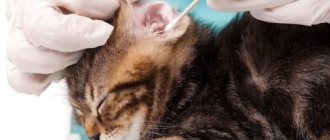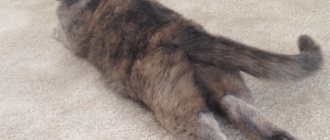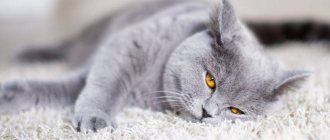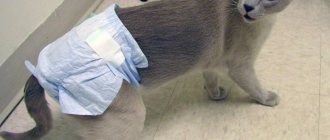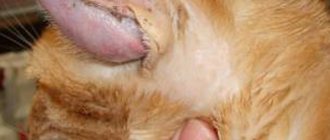If white feces are observed in a cat, this may indicate hepatitis of various etiologies, cholecystitis, cholelithiasis, infection with worms, and malignant neoplasms. The condition may be accompanied by jaundice, vomiting, fever, increased thirst and dangerous death of the animal. At the first symptoms, the owner should contact a veterinarian, who will diagnose the cat and prescribe treatment.
According to veterinarian statistics, 30% of diseases are liver pathologies, and the formation of stones in the bile ducts in cats is diagnosed 4 times more often than in cats.
Reasons why stool becomes lighter
Hepatitis of various etiologies
Normally, the color of a cat's stool is brown, formed, and moderately dense. When the liver and biliary tract become inflamed, the flow of bile is disrupted, which is why the cat has white feces. Hepatitis is non-infectious when an animal comes into contact with pesticides for a long time or accidentally ingests poisonous plants. Infectious inflammation is caused by bacteria and viruses. Symptoms:
- temperature increase;
- darkening of urine;
- yellowness of the mucous membranes and eye sclera;
- increased thirst;
- diarrhea or constipation (stool is excreted in round, dense grains);
- weight loss;
- heart rhythm disturbance.
Cholecystitis
With this non-arc, the animal does not feel the desire to play with anything.
With this disease, the gallbladder becomes inflamed, which leads to stagnation and decreased flow of bile. The cause of the disease is poor-quality or expired food, abdominal injuries, irregular nutrition, metabolic disorders, severe infectious diseases, and worms. In addition to the fact that the cat’s stool becomes gray or whitish, the following signs are observed:
- jaundice;
- frequent vomiting;
- loss of appetite;
- lethargy, refusal to play;
- dry mucous membranes;
- increased need for water;
- dull, patchy fur.
Cholelithiasis
Cholelithiasis is characterized by the formation of stones in the intrahepatic and biliary tracts and bladder that block the ducts. Most often it develops against the background of liver pathologies, as well as due to metabolic disorders of cholesterol, phospholipids, bilirubin, bile acids and pigments. This promotes the formation of thick bile and cholesterol crystals in it, which later become denser, forming stones. Symptoms:
The presence of stones in the gall bladder causes the pet to lose a lot of weight.
- jaundice;
- vomit;
- dehydration;
- decreased heart rate;
- abdominal pain;
- weight loss;
- white stool;
- skin itching.
Worm infestation
If a cat poops white feces, it may be liver damage from helminths such as fluke, roundworm, toxocara, cucumber tapeworm, hookworm. Worms and their eggs clog the bile ducts, disrupting the flow of bile. Parasites enter a cat's body by eating raw fish or meat, grass, drinking contaminated water, or licking its paws after a walk. Manifestation:
- stool is white or gray;
- vomit;
- itching in the anus, the cat “rides” on its butt;
- hair loss;
- skin rashes and redness;
- deterioration of wool structure;
- liver enlargement;
- yellowness of the sclera and mucous membranes;
- abdominal pain;
- refusal of food;
- stool instability.
Cancer tumor
With such a serious illness, the animal often goes to drink water.
A cat is diagnosed with sarcoma or carcinoma, which metastasizes and has a rapid progression. The formation of a tumor in the liver and bile ducts is most often secondary, occurring against the background of a lesion in the body. In addition to the light shade, there is a bloody admixture in the stool. In the initial stages, the disease is asymptomatic, then the following symptoms appear:
- vomit;
- increased thirst;
- sudden weight loss;
- anemia due to internal bleeding;
- diarrhea;
- yellowness of mucous membranes;
- lethargy, lack of vigor;
- frequent urge to urinate.
Causes of light-colored feces in babies
If a kitten has white stool, this may indicate a lack of enzymes secreted by the pancreas. Yellow feces occur if only milk is present in the baby’s diet. In older kittens, a deviation in color may indicate dyspepsia and fermentation processes in the gastrointestinal tract.
Stool color and consistency in a healthy animal
The appearance of feces allows you to assess the health of a cat, cat or kitten. Normally, feces should be:
- dark brown;
- well formed (into a sausage);
- dense;
- wet.
Feces have a specific, mild odor. If the stool smells strongly, this also indicates problems with digestion.
In animals that eat primarily meat, the color of their stool is deep brown. When your pet's diet is dominated by dairy products, the feces will turn light brown or yellow.
If a cat, cat or kitten has white stool, this indicates the development of the disease. The owner needs to observe the animal for several days. If the stool continues to be an unnatural color, you need to reconsider your pet's diet or consult a veterinarian.
Diagnostics
The reason for the lightening of excrement can be determined during an ultrasound of the animal’s hepatobiliary system.
To find out why a cat has light-colored stool, the veterinarian conducts an external examination of the animal and prescribes diagnostic methods, such as:
- scintigraphy;
- radiography;
- Ultrasound of the liver and biliary tract;
- general and biochemical blood test;
- fecal analysis for helminth eggs;
- biopsy.
How to Prepare Cat Stool Samples for Testing
At each annual exam, your veterinarian may ask you to bring a stool sample for laboratory testing. It is best to collect samples in special plastic containers, which can be purchased at both a veterinary and a “human” pharmacy. Just remember: the lab needs a fresh sample, so collect these “treasures” from the tray the day of your veterinarian visit. Once you collect the feces in an approved plastic specimen container, be sure to sign the date and time of collection so that your veterinarian has accurate information.
What to do if the stool is white?
Therapy is prescribed by a veterinarian, depending on the etiology of the disease; self-medication is prohibited. If a large stone is observed in cholelithiasis, surgery or crushing and removal of the crystals with a laser is performed. When a tumor is diagnosed, surgery should be performed. For hepatitis, hepatoprotectors and antispasmodics are prescribed. You can expel the cat parasite with anthelmintic drugs. If there are a lot of worms, surgical removal is required. Diuretics and choleretic drugs are also used. A diet is prescribed in the form of lean broth, oatmeal with water and vitamin and mineral complexes. Among the feeds, it is recommended to choose holistic or premium brands with the Sensitive mark.
Treatment
The key to successful treatment is a complete diet that takes into account the individual needs and condition of the cat. Please note that there can be no talk of cheap food or natural feeding “whatever is necessary”. Even if the cat feels well, small amounts of fatty, spicy, pickled, smoked or other junk food can dramatically worsen its health.
During diagnosis and treatment, the amount of water consumed is strictly controlled. When a cat is dehydrated, bile is not produced or not enough is produced.
When too much water is consumed (for a number of alarming reasons), bile loses concentration, leading to incomplete digestion of food. In the second case, the animal loses weight and suffers from vitamin deficiency.
If formed stones or a tumor that is compressing the liver is detected, there is only one way out - surgery. In all other cases, treatment is selected individually. If there is sand in the gallbladder, the cat is prescribed a therapeutic diet and choleretic drugs. Dissolving sand is a long process, but it does not require rough intervention.
Symptoms of helminthiasis
Signs of parasites appearing in an animal’s body can be different. Symptoms directly depend on the type of helminths that have entered the cat’s body and the degree of worm damage.
At the initial stage, the disease does not detect itself, but progresses very quickly, as a result of which the cat becomes weaker day by day.
The main signs of worm infection:
- The animal becomes lethargic and gets tired quickly.
- Small white worms appear in the cat's stool.
- The pet's belly becomes dense and severe bloating can be observed.
- The cat loses its appetite and may refuse food.
- The fur loses its shine and begins to fall out.
- Vomit.
- Problems with passing stool. Constipation alternates with intestinal upset.
- A cat can “ride” on its butt.
- The pet becomes nervous and restless.
Prevention
To ensure that your cat does not have problems with defecation, and that the color and consistency of feces always corresponds to the norm, it is important to follow simple preventive rules. Once every six months, the animal should be treated with anthelmintic drugs and treated for cat lice and fleas. In addition, it is worth adjusting the diet and, if necessary, switching to ready-made medicinal factory feed. If your pet's stool stinks and has an uncharacteristic color, it is forbidden to self-medicate. Only a treatment regimen correctly selected by a doctor will help eliminate the disease and prevent complications.
About your pets' excrement
In this article we will talk about a sensitive topic. about your pets' excrement, aka feces.
Any encyclopedia will tell you - feces (faeces; synonyms: feces, excrement) - the contents of the distal part of the large intestine, released during defecation.
Normally, cats have bowel movements once or twice a day, the stool is formed, slightly moist and soft, dark brown in color, there is no mucus, blood or undigested food in it. Ideally, the size of the stool should be significantly smaller than the amount of food on the plate (25%). When there is less output than input, the cat extracts more nutrients from the food. Large stools are caused by the presence of undigested filler in feed such as corn and other plant products.
Treatment methods for detecting pinworms in a child
To treat enterobiasis, the doctor prescribes anthelmintic drugs. The dosage is determined according to the age and weight of the patient. It must be remembered that all these drugs are highly toxic and can cause adverse reactions. Pediatricians do not recommend choosing medications without consulting a specialist.
If a child is diagnosed with pinworms, then all family members need to undergo treatment. If there is a pet living in the house, it is also necessary to purchase anti-worm medication for it.
During treatment, it is also necessary to take sorbents, since anthelmintic drugs do not remove parasites from the body.
An effective regimen for taking medications and necessary procedures is prescribed by the doctor.
A number of hygiene procedures for the home are necessary:
- after the end of treatment, change the linen by ironing it with a hot iron;
- boil or wash the toys in hot water with added salt;
- Regularly carry out wet cleaning at home.
What complications does the disease cause?
When the parasite attaches to the intestinal wall, it secretes a harmful secretion and damages the mucous membrane. In the latter case, poorly healing ulcers form and hemorrhages occur. If tissues are deeply damaged, inflamed granulomas appear. They consist of abnormally overgrown cells, lymph and blood. Due to the fact that pinworms injure the intestines, children experience abdominal pain. The microflora is disrupted and dysbacteriosis occurs.
When the female crawls out, she damages the soft tissue. The perianal area is irritated by the secretion of the worm - abrasions, cracks, eczematous rash, and neurodermatitis appear. If the helminth penetrates the genitals of girls, endometritis and other gynecological diseases may develop.
In the presence of pinworms the acidity of the stomach decreases , food is digested worse, and the course of intestinal diseases becomes more complicated . Parasites reduce immunity, because of them the effectiveness of vaccinations decreases and the number of side effects from them increases. Medicine knows of cases where pinworms pierced the rectum and entered the abdominal cavity, followed by peritonitis.
Being in the organs of the gastrointestinal tract, parasites cause the following complications:
- inflammation of the pelvis and peritoneum;
- acute skin lesions in the perirectal area;
- stagnation of feces in the cecum;
- pyoderma;
- anemia;
- developmental delay of the child;
- disturbance of appetite and sleep; Source: R.A. Fayzullina, E.A. Samorodnova, V.M. Dobrokvashina Helminth infections in childhood // Practical Medicine, 3(42) May 2010.
- in girls – cystitis, vulvitis;
- in boys - enuresis;
- anal fissures.
What is the cause of diarrhea in cats?
The causes of diarrhea in a pet can be situational, arising from errors in care, or serious, due to diseases of varying severity.
Household factors leading to disruption of the gastrointestinal tract and diarrhea:
- incorrect diet - feeding your pet fatty, smoked foods, raw fish, milk;
- overfeeding;
- a sharp change in the usual diet - replacing the natural method of feeding with dry food, changing food from wet to dry or vice versa;
- drinking water - a sudden change in the composition of water can adversely affect digestion;
- food poisoning – eating spoiled food;
- food allergies to certain foods;
- the cat’s body’s reaction to medications;
- postoperative recovery period;
- stress – the general condition of a cat in response to a change of environment, a trip, another animal, the absence of the owner;
- short-term diarrhea occurs in cats during pregnancy and after birth.
Among the diseases whose symptom is diarrhea are:
- bacterial infections - salmonella, E. coli and others;
- viruses - rotavirus, feline leukemia, peritonitis, panleukopenia and others;
- liver damage;
- pathologies of the digestive system, pancreatitis, intestinal obstruction;
- serious intoxication of the animal’s body due to poisoning;
- metabolic disorders, incl. diabetes;
- the presence of internal parasites - worms, worms, roundworms;
- oncological diseases;
- kidney disease;
- mycoses (fungal infections) of animals.
You can determine the specific cause of diarrhea in a cat by knowing the types of diarrhea.
Types of diarrhea and diagnosis
What do worm eggs look like?
Let's say you find something that looks like worms in your pet's stool, what should you do next? First, you need to understand what you see. Fecal matter may contain live and dead parasites, their eggs, incompletely digested food, and inedible objects that the cat swallowed accidentally or intentionally.
The range of parasites that a cat can become infected with amounts to hundreds of species. Each parasite belongs to a specific family, subfamily or species. Each type of worm has similar features: color, length, body shape, shape and color of eggs. First, let's figure out what worm eggs look like, which you can distinguish visually.
White round spots in stool - what is it?
Almost all worms that parasitize the body of cats are very modest in size and have microscopic eggs that are invisible to the human eye. The exception is tapeworms, which are also called tapeworms and tapeworms.
The body of these parasites consists of:
- Heads with oral apparatus, several rows of hooks and/or suckers.
- Segments (segments) that form a long body.
- This is incredible! Depending on the type of worm, its body can consist of 4–200 segments. Each segment is a vessel for 1–800 eggs, which must be released into the external environment.
The most common tapeworm that affects cats is the cucumber tapeworm (often called borage). Parasite eggs can be identified by visual signs:
- Round with slightly pointed tips, similar to sesame or cucumber seeds.
- White, slightly transparent.
- The main distinguishing feature is that the eggs move and move due to the flat muscles of the segment.
Tapeworm eggs are most often found:
- In feces.
- On the pet's bedding.
- On the fur around the anus.
The life cycle of borage has its own peculiarities. Each worm is hermaphrodite, meaning it reproduces and fertilizes its own eggs. The egg, released into the external environment, begins to move to find a temporary carrier. The egg is eaten by a flea (flea eater), which becomes a vessel for the maturation of the egg.
When the parasite is ready to molt, it hibernates and waits for the right conditions. A flea living on a cat gets caught in the pet's teeth when it tries to relieve the itching. The swallowed flea is digested, and the egg sheds as soon as it enters the intestines.
Once in a suitable habitat, the head of the parasite is implanted into the intestinal mucosa, in other words, it digs into it with hooks and begins to drink blood. Within 30–40 days, the worm matures and becomes sexually mature. Afterwards, the helminth begins to form segments, each of which contains a fertilized egg. The last segment (the tail of the worm) breaks off and comes out with the feces as soon as the egg is ready to “move” into the body of a temporary carrier.
How to help with diarrhea?
Only a veterinarian can prescribe specific antibiotic treatment for a kitten. But the owner himself can also help by giving the animal anti-diarrhea medications, as well as putting the kitten on a diet.
Diet
First, at home, it is recommended to completely limit the animal’s food intake. The fasting time depends on the age of the pet. An adult cat can easily withstand the absence of food for 24-40 hours, but a kitten - no more than 10-12 hours. Drinking water must always be available.
